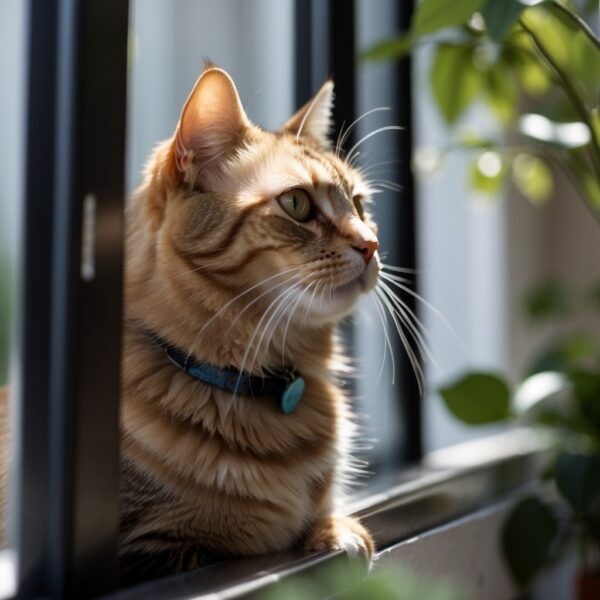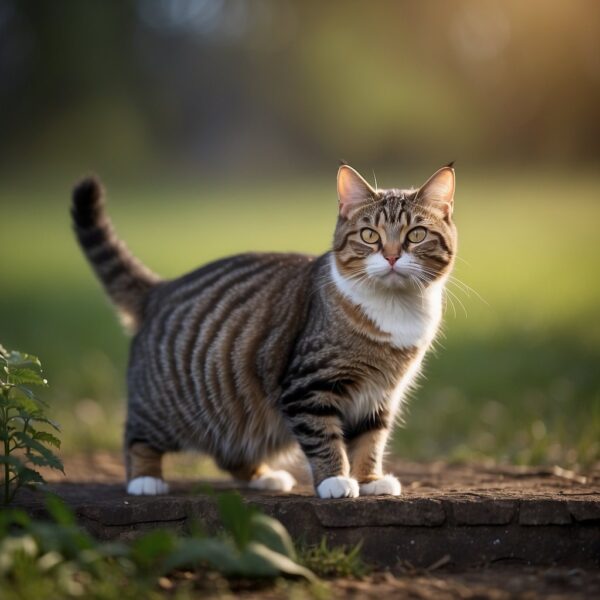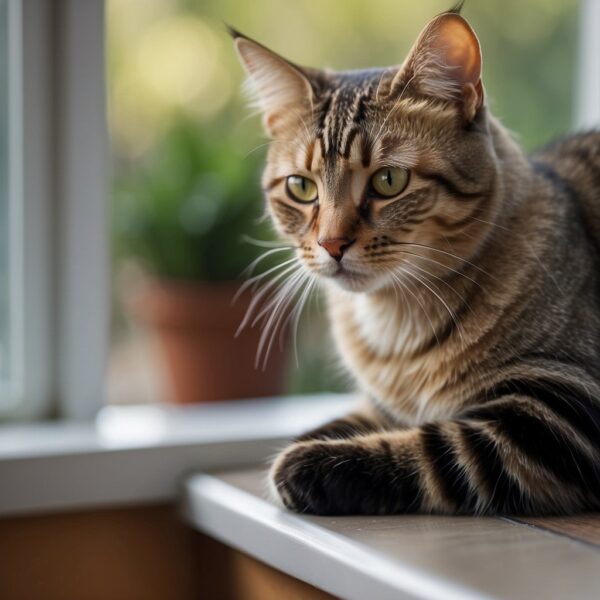
Cat Chattering: Understanding Feline Behavior
This behavior typically occurs when cats are perched near windows or are otherwise fixated on birds, squirrels, or other potential prey they spot outside. Cat parents may wonder why is my cat chattering ( sounds like ek-ek-ek) and what drives this peculiar conduct that seems to be a mix of vocalization and movement.
Despite the seemingly mysterious nature of chattering, it’s rooted in a cat’s predatory instinct and communicative needs. Several theories propose that chattering is a form of excitement or frustration when a cat spots prey it cannot pursue. This can be seen as a preparatory action for the precise kill bite cats use in hunting. Other considerations suggest a cat’s chattering could be a reaction to the adrenaline rush from the thrill of spotting a potential hunt, or an instinctive mimicry of the prey’s movements.
Key Takeaways
- Chattering can be linked to a cat’s inherent predatory instincts.
- It may signify either excitement or frustration in response to unattainable prey.
- Chattering can be a part of a cat’s multifaceted communication repertoire.
Understanding Cat Communication
Cats communicate through a complex system of vocalizations, body language, and behaviors that are often subtle and nuanced. This section delves into the feline language and its particular means of expression.
Basic Aspects of Feline Language
Feline language is multifaceted, encompassing various sounds and physical signals. Meowing is commonly used by cats to seek attention from humans, while sounds like purring typically signal contentment and pleasure. Other vocalizations include chirping, chittering, twittering, caterwauling, hissing, and yowling, each conveying different emotional states ranging from excitement to aggression. In addition to vocal sounds, cats utilize a rich body language. A stiffened tail, erect fur, and an arched back can indicate defensive or aggressive feelings, whereas a softly twitching tail or a head nudge might demonstrate affection and trust.
Chattering: One of the Feline Vocalizations
Chattering is a distinctive sound (ek-ek-ek) that is part of the feline communication repertoire. It often occurs in the context of hunting or when a cat is observing prey, such as birds or rodents, from a vantage point it cannot reach. The sound resembles a mix of a meow and a purr, with quick, repetitive dental chatters or clatters. Some theories suggest that chattering is a sign of frustration or excitement because the cat cannot pursue the prey. Others propose that it might be an instinctive mimicking of the kill bite used in hunting to sever the prey’s spine.
Communication With Humans
Cats have developed specialized ways to communicate with their human guardians. They often modulate their meows and other vocalizations to elicit a response or attention from humans. For instance, cats may use a high-pitched meow to indicate they want food or a softer chirrup to greet their human when they come home. Cat parents become attuned to their cats’ communication cues over time, understanding when their cat is seeking play, affection, or the need to be left alone. Observing a cat’s body language in conjunction with its vocal sounds is crucial in accurately interpreting its desires and emotional states.

Exploring the Hunting Behaviors of Cats
Cats exhibit a range of behaviors that are directly linked to their innate predatory instincts. Through understanding these behaviors, such as chattering, play, and vocalization, we gain insight into the complex nature of feline hunting tactics.
Predatory Instincts and Cat Chattering ek-ek-ek sound
Cats possess deeply ingrained predatory instincts which are a fundamental part of their behavior. These instincts can often be witnessed when a cat encounters potential prey, such as birds or squirrels. Chattering typically occurs when cats are observing prey, and their jaw muscles begin to twitch; this is thought to be either an expression of excitement or frustration or a preparatory movement for the act of killing.
The Role of Play in Mimicking Hunting
Playtime for domestic cats serves an important role in mimicking hunting experiences. Activities such as pouncing on toys and interacting with puzzle feeders are not only forms of exercise but also vital practice for honing their hunting skills. This type of play stimulates a cat’s prey drive, allowing them to practice the stalk and ambush techniques they would use in a real hunt.
Observed Prey and the chattering Vocalization
When a cat sits by a window observing critters like squirrels and flies, it is common to hear them vocalize ,with the ek-ek-ek sound, their interest or excitement. This vocalization, often in the form of chattering, may be in response to visual stimuli such as the sight of a prey animal. The chattering might coincide with tail twitching and intense focus, indicating the cat’s engagement with its predatory nature.
The Chattering Phenomenon Explained
Exploring the curious behavior of cat chattering provides insights into feline instincts and emotional states. This section delves into scientific interpretations, the emotional implications of chattering, and how this behavior is connected to cats’ interactions with wildlife.
Scientific Theories Behind Chattering
Scientific inquiry has offered several theories to explain why cats engage in chattering. One prevalent theory suggests that chattering is an instinctual response linked to the predatory behavior of their ancestors. The jaw movement might imitate the sound of prey like the pied tamarin monkey, signifying both an indication of the presence of prey to other cats and a practice of their hunting skills.
Link Between Chattering and Emotional States
Chattering can also be a window into a cat’s emotional state. When chattering occurs in sight of prey, such as birds outside a window, it may be associated with a high level of excitement or anxiety. The release of adrenaline indicates a heightened state of arousal, which could be a mix of pleasure, frustration, or anticipation due to the inability to pursue the prey.
Chattering in Relation to Wildlife
Chattering may also express a connection between domestic cats and their wild cousins. Felines, both domestic and wild cat species, exhibit similar behaviors when observing or interacting with wildlife. The act of chattering, the ek-ek-ek sound, can mirror their innate predatory behavior, displaying their natural impulse to stalk and hunt even in a non-wild environment.

Health and Behavioral Issues
Cat chattering is often a natural behavior, but it can sometimes be a sign of health or behavioral issues that require attention.
When Chattering May Indicate a Health Problem
Chattering might signal a health issue such as dental disease if it is accompanied by signs of pain or discomfort. Cats with dental issues may chatter due to the discomfort in their mouth, and you might notice they are hesitant to eat or touch their face. If a cat chatters continuously and shows signs of distress, it could suggest an underlying health problem that needs a veterinarian’s evaluation.
Behavioral Concerns: When to Consult a Veterinarian
Behaviorally, excessive chattering combined with a change in general demeanor—such as appearing angry or showing annoyance—could indicate stress or anxiety. If a cat’s chattering seems to be a result of a behavioral issue rather than play, and it is persistent or associated with other changes in behavior, a consultation with a veterinarian can help determine if there’s a deeper concern that needs addressing.
Mother Cat’s Influence on Kittens’ Behavior
A mother cat plays a crucial role in teaching her kittens essential life skills. This includes hunting skills, where kittens may mimic chattering after watching their mother. However, if a kitten seems overly fixated on chattering, especially outside of playtime, this could suggest early signs of anxiety or stress. Observing how a mother cat responds to her kittens’ chattering can provide insights into whether the behavior is a normal part of learning or if there could be a problem.
Interacting With Your Chattering Cat
Cats communicate in various ways, and chattering is one behavior that fascinates their guardians. Interacting with a chattering cat offers insights into their emotional states and provides an opportunity for strengthening the bond between feline and owner.
Encouraging Appropriate Play and Stimulation
Cat parents can introduce toys that mimic prey, such as wind-up mice or feather wands, to encourage natural predatory behavior and provide necessary exercise. These play sessions should imitate a real hunt to satisfy the cat’s instincts. Puzzle feeders also stimulate the cat mentally, making playtime both fun and rewarding.
Responding to Your Cat’s Chattering
When your cat starts chattering at birds or squirrels outside the window, they are displaying natural behaviors. Responding to this communication by talking back or mimicking their ek-ek-ek sounds, can enhance your bond and acknowledge their presence and feelings. If the chattering is a result of attention-seeking, providing a brief play session can fulfill their desire for interaction.
Building a BonD: Understanding Cat Chattering
Understanding your cat’s trilling and chattering is crucial for building a strong bond. It offers insights into their feelings and needs. Engaging with them during these moments, whether it’s through a quick pet, a playful gesture, or simply talking to them, shows you’re paying attention. Feline communication is complex, and chattering is just one way they convey their emotions and desires. Being responsive creates a deeper connection.

Frequently Asked Questions about cat chattering
The purpose of this section is to address some of the common queries related to the peculiar behavior of cat chattering.
What causes a cat to chatter when observing birds?
A cat may chatter , the rapid ekekek sound, when observing birds due to their instinctual predatory behavior. This action is believed to be connected to the excitement and frustration of spotting potential prey they cannot reach.
Can chattering indicate a health issue in cats?
Chattering is typically a normal feline behavior associated with hunting instincts. However, if it is accompanied by other unusual symptoms, it could indicate dental issues or other health problems, and a veterinary consultation is advised.
Is it common for cats to chatter in presence of other cats?
Chattering is generally observed when cats are focused on prey and not commonly directed towards other cats. However, it might occur in a multi-cat household where one cat is observing prey and the other cats are in proximity.
What are the implications of a cat chattering during hunting behavior?
Chattering during hunting behavior may be an expression of anticipation or excitement. It is also thought to practice the precision killing bite used on prey by mimicking the motion.
Why might a cat chatter when looking at the ceiling or other high places?
A cat might chatter when looking at the ceiling or other high places if it senses the movement of insects or other small animals that might trigger its hunting instinct even if they are not visible to humans.
Does chattering serve a communication purpose between cats and humans?
While chattering is primarily associated with hunting behavior, it may attract the attention of humans. However, it is not typically used as a direct form of communication between cats and their human companions.